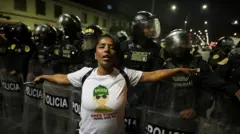Police and young anti-government protesters clashed in the Peruvian capital, Lima, over the weekend.
A rights group reported that at least 18 protesters were injured during the events known as the 'Gen Z march,' organized to express anger over persistent corruption scandals and increasingly dangerous living conditions. A police officer also suffered burns amidst the unrest.
The protests surged as groups of young people, primarily under 30, banded together with taxi and bus drivers, marching towards Congress to voice their frustrations.
Some protesters resorted to throwing stones and other projectiles, prompting the police to retaliate with tear gas and rubber bullets, according to reports by AFP.

The demonstrations commenced on Saturday, September 20, following the enactment of a pension reform that mandates young Peruvians contribute to a private pension fund.
President Dina Boluarte's approval rating has dwindled into single digits, fostering widespread calls for her resignation.
'We are marching against corruption, for life, and against the crime that is killing us every day,' stated 28-year-old Adriana Flores during the protest.
The Gen Z demonstrators were accompanied by transport workers who highlighted the government’s inaction on extortion issues. Taxi and bus drivers reported threats from gangs demanding 'protection money,' and accused the police of neglecting this rampant extortion.
Some protesters brandished placards stating, 'We demand a life without fear.'
Human rights group CNDDHH condemned the police response, asserting that the use of extensive tear gas was unjustifiable.
Chanting for a 'united Peru we deserve,' protesters reached the security barriers set up around Congress, where they sang the national anthem amid critical views towards the legislative body.
Frustration with Congress is widespread, with many Peruvians believing that lawmakers prioritize self-interest over the people's welfare. Boluarte has also faced backlash for doubling her own salary in July, an act criticized as outrageous given her low approval ratings.
Her term is scheduled to conclude in July of the following year amidst this ongoing unrest.
The current turmoil in Peru highlights the deeper societal issues and the voices of a disillusioned youth demanding for substantial change.



















